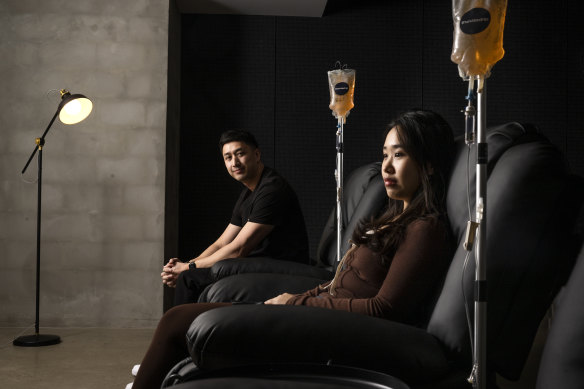Intravenous infusion treatments spruiked as being able to cure hangovers or bolster immunity are surging in popularity, as doctors call for a crackdown on the unregulated market.
Two dozen new infusion companies have registered with the Australian Business Register in the past five years.
Mobile clinics have also emerged, with nurses travelling to homes to administer treatments in backyards or living rooms. Some companies provide corporate wellness packages for employees to undergo infusions at retreats or in their workspaces.
Prices range from $200 for vitamin C to $700 for “biohacking” coenzyme drips, with providers offering to prepare a personalised cocktail of nutrients claiming to reduce stress, sharpen focus and improve energy levels.

Director of The Vita Drip Richard Phanic said demand for vitamin and nutrient IVs has surged in the past few years amid a wellness craze. Credit: Louise Kennerley
The demand comes amid an extreme global shortage of IV products, with Australian doctors asked to cut back on IV fluids and specialists warning some non-urgent surgeries may be cancelled.
Vitamin infusions are not approved or regulated by the Therapeutic Goods Administration, and there’s limited evidence to suggest many of these therapies are more beneficial than drinking water or taking a vitamin supplement.
Director of mobile IV service The Vita Drip, Richard Phan, said demand had exploded post-pandemic. He is servicing mostly burnt-out employees looking to boost their energy levels and immunity.
“The clientele we mostly see are young professionals,” he said. The company’s most popular products are vitamin B and C infusions, antioxidants and nicotinamide adenine dinucleotide therapy, a molecule spruiked as being able to manage the effects of ageing.
Phan acknowledged research on IV infusions was “in its infancy”.
“There’s no patent on these products, so there’s no incentive for companies to invest time and money researching,” he said.
At IV Health, which started eight years ago, co-director Naomi Goldbaum said demand had increased.
“People are taking a more preventative approach to health and wellness and supporting their immune system rather than treating themselves when they’re already sick,” she said.
Some clients come in monthly, and others weekly when unwell, which she says is a testament to the infusions’ impact.
Goldbaum said the clinic was careful when advertising its products, and is unable to name some nutrients in the drips due to TGA regulations.
The Australian Health Practitioner Regulation Agency has previously raised concerns about advertising of unproven IV infusion treatments. A spokesperson said while complaints remained low, their concerns were ongoing.
“Clinics providing unproven infusion services must be honest with their clients about the lack of scientific evidence supporting their use, as the marketing of this industry has outpaced the medical justification for many treatments,” the spokesperson said.
“Clinical interventions should only be provided when necessary, and patients need to be aware of infection and other risks which come with all medical treatments.”
In 2023, the regulator fine Drip IV Australia nearly $160,000 for labelling its products as “miraculous”. The company also made advertising claims regarding cancer, alleviating COVID-19 symptoms and Alzheimer’s.
Royal Australian College of General Practitioners president Dr Nicole Higgins said misleading marketing was of concern during a global shortage.
“At a time when we’ve got a shortage of IV equipment, we need to preserve it for those who need it for medical reasons, versus those that are taking it because they’ve been pitched to by marketing,” she said.
The shortage is due to unexpected global demand and manufacturing issues, with supply constrained until the end of the year.
Higgins said IV infusions in non-clinical settings risked contamination, which could cause infection or clots. Others may experience an allergic reaction to the drip.
In higher doses, some vitamins can also be toxic.
“An IV drip is an invasive medical procedure, and it’s not there as a marketing or business opportunity,” Higgins said.
A spokesperson for federal Health Minister Mark Butler said the government was working with public and private health providers to address the IV shortage.
“The TGA has approved a number of alternative supplies from overseas to supplement the local production, which is managing to get us through this period of higher demand,” he said.
The Morning Edition newsletter is our guide to the day’s most important and interesting stories, analysis and insights. Sign up here.